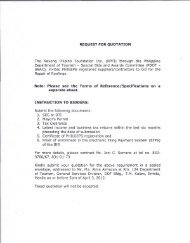regulatory impact assessment (ria) guidelines - It's More Fun in the ...
regulatory impact assessment (ria) guidelines - It's More Fun in the ...
regulatory impact assessment (ria) guidelines - It's More Fun in the ...
Create successful ePaper yourself
Turn your PDF publications into a flip-book with our unique Google optimized e-Paper software.
PHILIPPINES - REGULATORY IMPACT ASSESSMENT (RIA) GUIDELINES<br />
DRAFT – FOR DISCUSSION AND FINALISATION<br />
KEY ASSESSMENT ISSUES<br />
5.1 Assessment of Impacts<br />
Often a wide variety of <strong>impact</strong>s result from regulation. Impacts <strong>in</strong>clude economic, competition, <strong>in</strong>ternational agreements, compliance and<br />
adm<strong>in</strong>istrative, social and environmental <strong>impact</strong>s on all stakeholder groups affected (bus<strong>in</strong>ess, community and government) by <strong>the</strong> regulation.<br />
Both <strong>the</strong> PIA and RIS require an <strong>assessment</strong> of <strong>impact</strong>s of <strong>regulatory</strong> options. Generally, a cost benefit analysis (CBA) is used to quantify and<br />
assess <strong>impact</strong>s. While a detailed CBA is not required <strong>in</strong> a PIA, it can be useful to assess <strong>the</strong> significance of <strong>impact</strong>s. A detailed CBA is required<br />
<strong>in</strong> a RIS.<br />
The CBA is a tool that measures that quantifies <strong>the</strong> value <strong>in</strong> today’s dollars of benefits and costs associated with <strong>the</strong> <strong>impact</strong>s of each <strong>regulatory</strong><br />
option identified. These values are exam<strong>in</strong>ed aga<strong>in</strong>st a base case, which is <strong>the</strong> value determ<strong>in</strong>ed for <strong>the</strong> current <strong>regulatory</strong> position.<br />
However, not all <strong>impact</strong>s may be able to be quantified (eg., <strong>the</strong> level of effort to quantify may not be able to be justified because of <strong>the</strong><br />
<strong>in</strong>significance of <strong>the</strong> <strong>impact</strong>, or <strong>the</strong> required <strong>in</strong>formation is not available). In this case, <strong>the</strong> benefits and costs of <strong>impact</strong>s should be described <strong>in</strong> a<br />
qualitative way so that <strong>regulatory</strong> options can still be compared.<br />
Accord<strong>in</strong>gly, <strong>impact</strong> <strong>assessment</strong> generally follows a 3-step process:<br />
1. Establish a base case for <strong>the</strong> current <strong>regulatory</strong> position – conduct an <strong>impact</strong> <strong>assessment</strong> for <strong>the</strong> current <strong>regulatory</strong> position (even if <strong>the</strong>re<br />
is no regulation) and determ<strong>in</strong>e <strong>the</strong> net benefit (cost) position<br />
2. Establish an <strong>impact</strong> <strong>assessment</strong> for each <strong>regulatory</strong> option - conduct an <strong>impact</strong> <strong>assessment</strong> for each <strong>regulatory</strong> and determ<strong>in</strong>e <strong>the</strong> net<br />
benefit (cost) position of each option<br />
3. Compare <strong>the</strong> results of <strong>the</strong> <strong>impact</strong> <strong>assessment</strong> for each <strong>regulatory</strong> option aga<strong>in</strong>st <strong>the</strong> base case and determ<strong>in</strong>e which provides <strong>the</strong> greatest<br />
net benefit to <strong>the</strong> Philipp<strong>in</strong>es.<br />
The <strong>regulatory</strong> burden (that is, red tape aris<strong>in</strong>g from unnecessary or excessive <strong>regulatory</strong> requirements) on bus<strong>in</strong>ess, community and government<br />
should be m<strong>in</strong>imised. The greater <strong>the</strong> <strong>regulatory</strong> burden, <strong>the</strong> higher <strong>the</strong> compliance costs, and <strong>the</strong> more significant <strong>the</strong> <strong>impact</strong> on bus<strong>in</strong>ess<br />
efficiency and performance. The compliance and adm<strong>in</strong>istrative burdens imposed by a regulation should be proportionate to <strong>the</strong> objectives of <strong>the</strong><br />
regulation.<br />
Version 4.0 23 July 2012 DRAFT Page 21/24
















